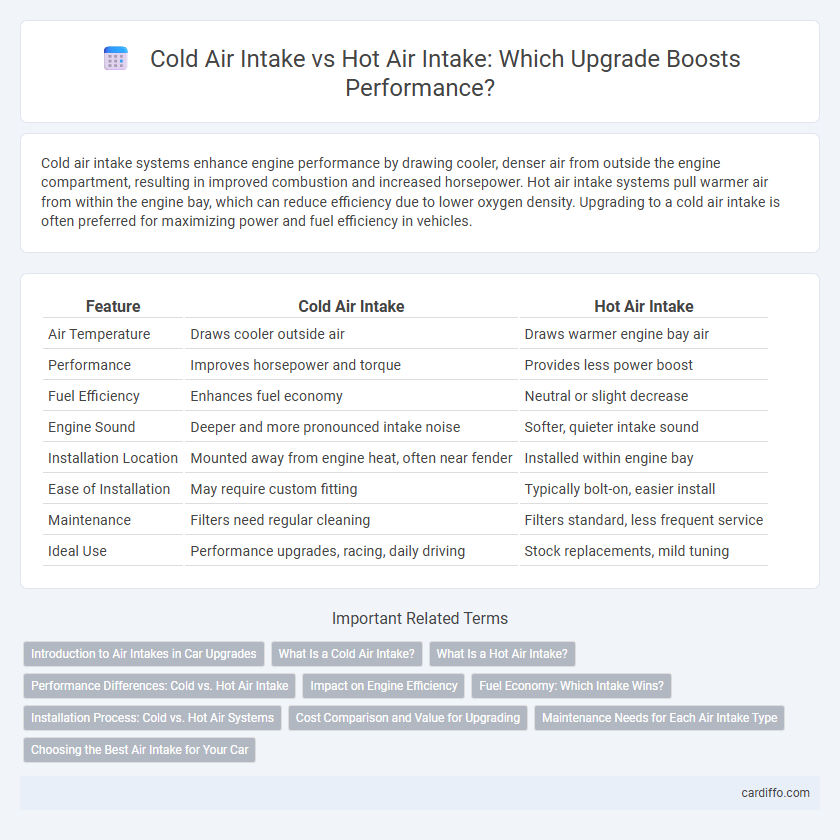Cold air intake systems enhance engine performance by drawing cooler, denser air from outside the engine compartment, resulting in improved combustion and increased horsepower. Hot air intake systems pull warmer air from within the engine bay, which can reduce efficiency due to lower oxygen density. Upgrading to a cold air intake is often preferred for maximizing power and fuel efficiency in vehicles.
Table of Comparison
| Feature | Cold Air Intake | Hot Air Intake |
|---|---|---|
| Air Temperature | Draws cooler outside air | Draws warmer engine bay air |
| Performance | Improves horsepower and torque | Provides less power boost |
| Fuel Efficiency | Enhances fuel economy | Neutral or slight decrease |
| Engine Sound | Deeper and more pronounced intake noise | Softer, quieter intake sound |
| Installation Location | Mounted away from engine heat, often near fender | Installed within engine bay |
| Ease of Installation | May require custom fitting | Typically bolt-on, easier install |
| Maintenance | Filters need regular cleaning | Filters standard, less frequent service |
| Ideal Use | Performance upgrades, racing, daily driving | Stock replacements, mild tuning |
Introduction to Air Intakes in Car Upgrades
Cold air intakes improve engine performance by drawing cooler, denser air from outside the engine bay, increasing oxygen levels for better combustion and power output. Hot air intakes, in contrast, pull warmer air from inside the engine bay, which is less dense and can reduce engine efficiency. Upgrading to a cold air intake is a popular modification among car enthusiasts seeking enhanced horsepower, improved throttle response, and better fuel efficiency.
What Is a Cold Air Intake?
A cold air intake is an aftermarket engine modification designed to bring cooler air into the engine, improving combustion efficiency and increasing horsepower. By drawing air from outside the engine bay, where temperatures are lower, a cold air intake helps reduce air density loss compared to hot air intakes that draw warmer air from inside the engine compartment. This results in better throttle response, enhanced fuel economy, and optimized engine performance.
What Is a Hot Air Intake?
A hot air intake draws air from the engine bay, where temperatures are significantly higher than outside, resulting in warmer, less dense air entering the engine. This type of intake can improve throttle response and fuel vaporization in cold climates, enhancing engine performance under specific conditions. However, the increased air temperature typically reduces overall power output compared to a cold air intake, which sources cooler, denser outside air.
Performance Differences: Cold vs. Hot Air Intake
Cold air intake systems enhance engine performance by drawing denser, cooler air, which increases oxygen availability and improves combustion efficiency. Hot air intake systems, on the other hand, pull warmer air that is less dense, resulting in lower oxygen levels and reduced engine power output. The temperature difference between cold and hot air intakes directly affects air density and, consequently, horsepower and torque gains.
Impact on Engine Efficiency
Cold air intake systems improve engine efficiency by drawing denser, cooler air into the combustion chamber, resulting in better oxygen availability and enhanced fuel combustion. Hot air intake systems, while easier to install, often reduce power output due to higher intake temperatures causing less dense air and slower combustion. Optimizing air temperature intake directly affects volumetric efficiency, contributing to improved horsepower and torque.
Fuel Economy: Which Intake Wins?
Cold air intake systems improve fuel economy by delivering denser, oxygen-rich air to the engine, enhancing combustion efficiency and increasing miles per gallon. Hot air intake systems, drawing air from the engine bay, typically raise intake air temperature, reducing air density and potentially lowering fuel efficiency. Studies show cold air intakes can boost fuel economy by up to 10% under optimal driving conditions compared to stock or hot air intakes.
Installation Process: Cold vs. Hot Air Systems
Cold air intake systems require relocating the air filter closer to a cooler area, often involving additional brackets or heat shields to prevent engine heat absorption, resulting in a slightly more complex installation. Hot air intake systems typically utilize the stock airbox and intake path, making installation quicker and simpler with fewer modifications needed. Proper sealing and positioning are essential in both systems to ensure optimal airflow and engine performance.
Cost Comparison and Value for Upgrading
Cold air intake systems typically cost between $150 and $400, offering better engine performance and fuel efficiency by drawing cooler, denser air compared to hot air intakes, which are generally less expensive, ranging from $50 to $150. Despite the higher initial investment, cold air intakes provide greater long-term value through improved horsepower and throttle response, making them a popular upgrade for performance enthusiasts. Hot air intakes may appeal to those on a tight budget but usually deliver marginal gains without significant enhancement in engine efficiency or power.
Maintenance Needs for Each Air Intake Type
Cold air intakes generally require less frequent maintenance due to their sealed filter designs that prevent debris infiltration, enhancing engine efficiency and longevity. Hot air intakes, while simpler in construction, often need regular cleaning and filter replacement to avoid clogging from warmer, dust-laden air that can reduce under-hood air quality. Choosing the right intake impacts engine performance, with maintenance intervals varying based on air conditioner exposure and driving conditions.
Choosing the Best Air Intake for Your Car
Cold air intake systems improve engine performance by delivering denser, cooler air, which increases oxygen levels for better combustion efficiency. Hot air intake systems, while more common in stock vehicles, draw warmer air from inside the engine bay that reduces engine power due to lower oxygen density. Choosing the best air intake depends on factors like desired power gains, driving conditions, and engine compatibility, with cold air intakes generally preferred for enhanced horsepower and throttle response.
cold air intake vs hot air intake Infographic

 cardiffo.com
cardiffo.com